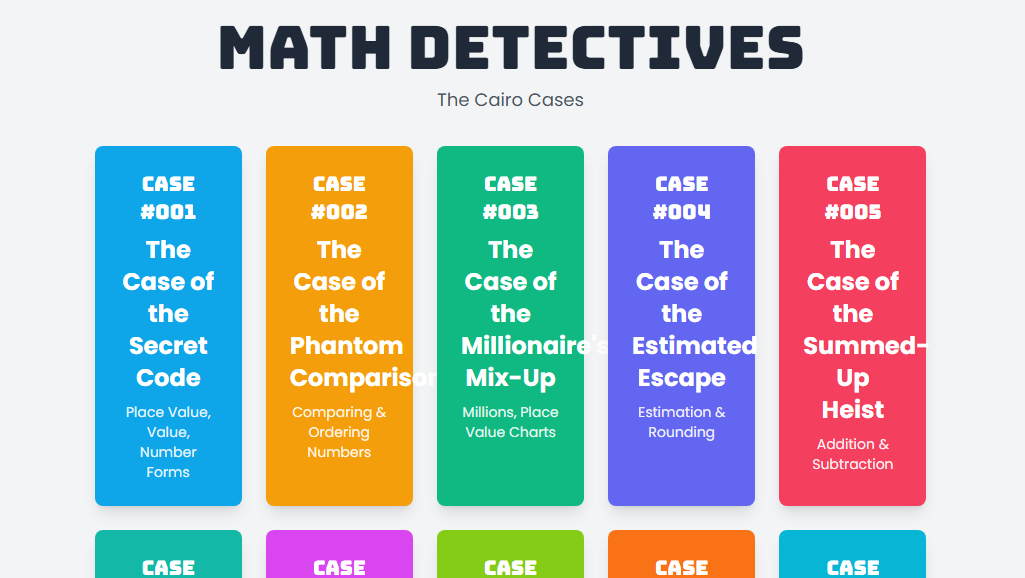A Teacher's Guide to "Math Detectives: The Cairo Cases"
Introduction: Transforming Math Practice into a Grand Adventure
Welcome, educators, to "Math Detectives: The Cairo Cases," an interactive learning game designed to transform standard math practice into an exciting, narrative-driven adventure. This guide is crafted to help you, the teacher, effectively integrate this tool into your classroom, particularly for Grade 4 English as a Second Language (ESL) students. The game is built directly from the "Summer Course G4 2025" workbook, turning its lessons into a series of ten compelling police cases that students must solve. By combining gamification with targeted curriculum, we can capture students' imagination, boost their engagement, and make learning math a truly attractive and rewarding experience.
The Educational Philosophy: Why a Game?
The core challenge in teaching math, especially to ESL students, often lies in overcoming the abstract nature of numbers and the language barrier of word problems. "Math Detectives" tackles this head-on through a carefully considered educational philosophy based on three pillars:
Narrative-Based Learning: Instead of presenting isolated problems, each mathematical concept is wrapped in a story. Students aren't just "finding the difference"; they are calculating a robber's leftover money to track his spending. This context makes the math purposeful and memorable. The police case theme is universally engaging, tapping into a child's natural curiosity and desire to solve puzzles.
Scaffolding for ESL Students: The game is designed with the specific needs of language learners in mind. Every case begins with a "Case Briefing" that pre-teaches essential vocabulary and summarizes the mathematical "laws" or rules needed to succeed. The language throughout the game is simple, direct, and repetitive, reinforcing both mathematical and English language skills simultaneously in a low-pressure environment.
Gamification and Modern Design: Children today are digital natives. The game leverages this by using a modern, vibrant, and intuitive interface. Features like color-coded cases, immediate feedback, and a clear sense of progression (solving clues to close a case) provide the motivation that traditional worksheets often lack. Each correct answer is a small victory, building confidence and encouraging students to persevere through more challenging problems.
How to Use the Game in the Classroom: A Step-by-Step Walkthrough
Integrating "Math Detectives" is simple. The game is structured to be intuitive for both teachers and students. Here’s a recommended approach for implementation:
Step 1: The Main Menu - Choosing a Case The game opens to a vibrant main menu displaying all ten cases. Each case card is color-coded and clearly labeled with its title and the math topics it covers (e.g., "Case #001: The Case of the Secret Code - Place Value, Value, Number Forms"). This allows you to easily align a case with your current lesson plan.
Step 2: The Case Briefing - Preparing for the Mission This is arguably the most crucial step for maximizing learning, especially for ESL students. When a student selects a case, a modal window appears with the full briefing. It is highly recommended to go through this section as a class or in small groups.
Case Concept: Read the short story aloud. This sets the stage and gets students invested in the narrative. Ask them what they think the mystery is about.
Key Vocabulary: Review each vocabulary word and its simple definition. Connect it to words they may already know. For example, when they see "Perimeter," you can explain it as the "border" or "edge" of a shape.
Detective's Laws: Discuss the mathematical rules. These are simplified summaries of the core concepts from the workbook. This primes the students' brains for the type of thinking required to solve the clues.
Step 3: Solving the Clues - The Investigation Once the case begins, students will be presented with one clue at a time. Each clue is a math problem drawn directly from the workbook.
Students read the problem and type their answer into the input field.
Upon submitting, they receive immediate feedback. A green message indicates a correct answer, while a red one encourages them to try again. This instant, non-judgmental feedback loop is vital for building resilience.
If a student is stuck, this is the perfect moment for intervention. You can refer them back to the "Detective's Laws" or the corresponding page in their physical workbook for a more detailed explanation.
Step 4: Case Closed! - The Reward After solving all the clues in a case, students are greeted with a "Case Closed!" screen. This celebratory conclusion provides a powerful sense of accomplishment and reinforces the idea that their math skills are the key to success.
Classroom Implementation Strategies
"Math Detectives" is flexible and can be used in various ways to suit your classroom's needs:
Topic Introduction (Whole Class): Project the game on a smartboard to introduce a new chapter. Work through the first case together, generating excitement and providing a clear, contextualized example of the concepts before they tackle the workbook.
Individual Practice (Learning Stations): Set up the game on tablets or computers as part of a math learning station. Students can work through the cases at their own pace, allowing you to provide targeted support to individuals or small groups.
Collaborative Review (Paired/Group Work): Place students in pairs or small groups to solve a case together. This is an excellent strategy for ESL learners, as it encourages them to use mathematical language, discuss strategies, and explain their reasoning to a peer.
Homework & Reinforcement: Assign a specific case for homework to reinforce a lesson taught in class. Because it’s a game, students are often more motivated to complete it than a traditional worksheet.
By using "Math Detectives: The Cairo Cases," you are not just teaching math; you are creating an immersive experience where students become the heroes of their own learning journey. You are giving them the context to understand the "why" behind the numbers and the confidence to tackle any problem that comes their way—in the classroom and beyond.

